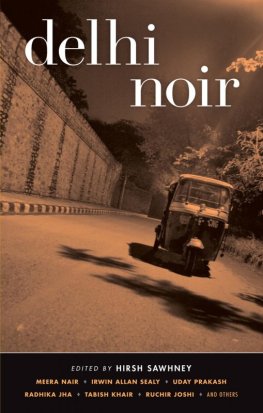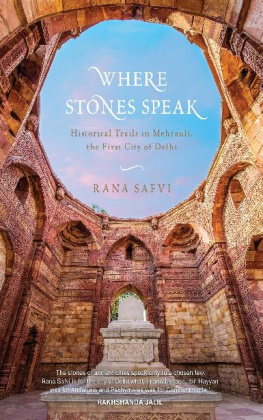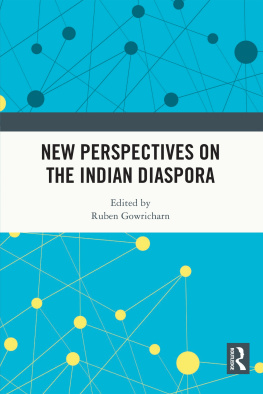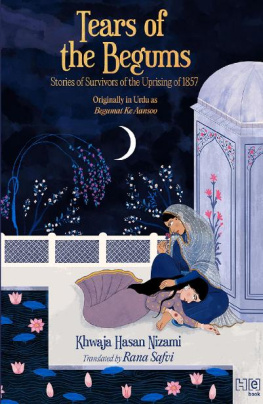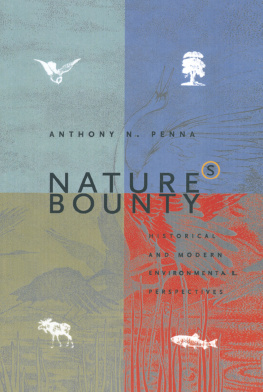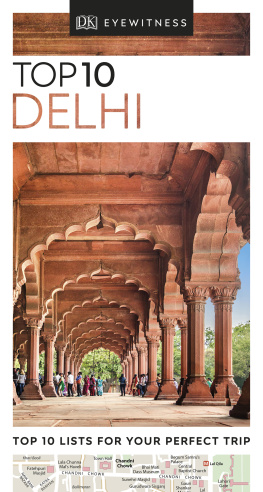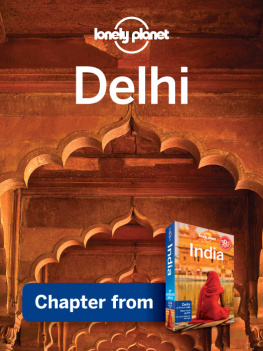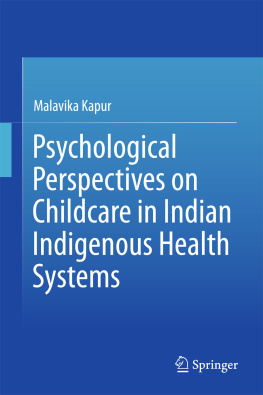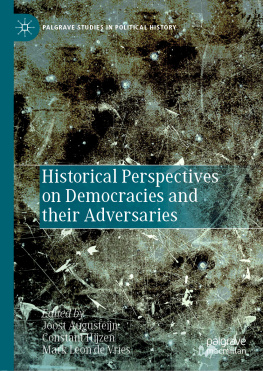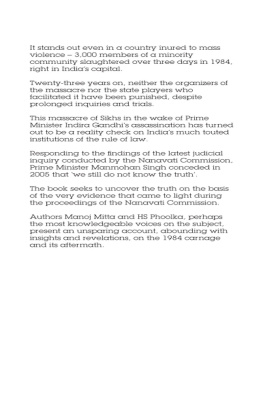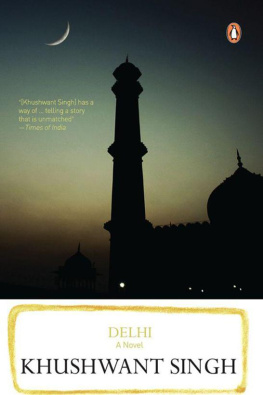K.A. Nizami - Delhi in Historical Perspectives
Here you can read online K.A. Nizami - Delhi in Historical Perspectives full text of the book (entire story) in english for free. Download pdf and epub, get meaning, cover and reviews about this ebook. year: 2020, publisher: OUP India, genre: Religion. Description of the work, (preface) as well as reviews are available. Best literature library LitArk.com created for fans of good reading and offers a wide selection of genres:
Romance novel
Science fiction
Adventure
Detective
Science
History
Home and family
Prose
Art
Politics
Computer
Non-fiction
Religion
Business
Children
Humor
Choose a favorite category and find really read worthwhile books. Enjoy immersion in the world of imagination, feel the emotions of the characters or learn something new for yourself, make an fascinating discovery.
Delhi in Historical Perspectives: summary, description and annotation
We offer to read an annotation, description, summary or preface (depends on what the author of the book "Delhi in Historical Perspectives" wrote himself). If you haven't found the necessary information about the book — write in the comments, we will try to find it.
Delhi in Historical Perspectives — read online for free the complete book (whole text) full work
Below is the text of the book, divided by pages. System saving the place of the last page read, allows you to conveniently read the book "Delhi in Historical Perspectives" online for free, without having to search again every time where you left off. Put a bookmark, and you can go to the page where you finished reading at any time.
Font size:
Interval:
Bookmark:
Delhi in Historical Perspectives
Delhi in Historical Perspectives
K. A. Nizami
Translated from Urdu by
Ather Farouqui


Oxford University Press is a department of the University of Oxford.
It furthers the Universitys objective of excellence in research, scholarship,
and education by publishing worldwide. Oxford is a registered trademark of
Oxford University Press in the UK and in certain other countries.
Published in India by
Oxford University Press
22 Workspace, 2nd Floor, 1/22 Asaf Ali Road, New Delhi 110 002, India
Oxford University Press 2020
The moral rights of the author have been asserted.
First Urdu edition published as Auraq-e musawwar, Ehd-e wusta ki Dilli in 1972.
Second Urdu edition published as Dilli tareekh ke aaine mein in 1989.
First published in English by Oxford University Press in 2020.
All rights reserved. No part of this publication may be reproduced, stored in
a retrieval system, or transmitted, in any form or by any means, without the
prior permission in writing of Oxford University Press, or as expressly permitted
by law, by licence, or under terms agreed with the appropriate reprographics
rights organization. Enquiries concerning reproduction outside the scope of the
above should be sent to the Rights Department, Oxford University Press, at the
address above.
You must not circulate this work in any other form
and you must impose this same condition on any acquirer.
ISBN-13 (print edition): 978-0-19-012400-7
ISBN-10 (print edition): 0-19-012400-8
ISBN-13 (eBook): 978-0-19-099190-6
ISBN-10 (eBook): 0-19-099190-9
Typeset in ScalaPro 10/15
by The Graphics Solution, New Delhi 110 092
Printed in India by Rakmo Press, New Delhi 110 020
Contents
Very few cities in the world, writes Professor Nizami, had been a centre of attraction as gorgeous a blaze of glory as Delhi. It was the rich soil of Delhi that accorded it the status of an international city during the medieval period, when diverse Indian cultures flourished there. Delhi in Historical Perspectives, a collection of research papers presented at the University of Delhi and the Ghalib Institute, New Delhi, consists of three chapters: poverty, abstinence and revelry, forts and hutments, and holy shrines and pleasure houses existed side by side. Nizami captures both the brighter and darker aspects of Delhi and its life quite brilliantly. He argues that the people of Delhi constituted a family and were like the beads of a rosary threaded into a string. He aptly quotes celebrated Persian and Urdu poets to substantiate his arguments. His treatment of Ghalibs personality as well as Ghalibs poetry and letters is very sensitive and insightful. He selects stories and events from history to back his narrative and weaves them with the evidence that he gathers from different sources. He imparts freshness and new dimensions to his subject matter with commendable treatment and presentation.
Delhi in Historical Perspectives abounds, like a literary text, in culture-specific words, symbols, metaphors, similes, idiomatic expressions, and other literary devices. These are so embedded in the language of the text that it was quite difficult for me to transplant them in another verbal space and linguistic matrix. The problems that I encountered during the translation of the book concerned lexical and cultural equivalences. In order to negotiate them, I have tried my best to strike a balance between the foreignness and domestication of the target language. In certain footnotes, the information as provided by Nizami in the Urdu original has been retained as is, owing to the difficulty of tracking down the actual sources for more details. The sources of some of the Urdu verses have not been given by Nizami and I have retained this absence on account of their familiarity to Urdu scholars. Similarly, there may be some inconsistencies in the text which have been reproduced by me in the translation.
I owe a deep debt of gratitude to Professor Sharif Husain Qasemi of the University of Delhi, who translated for me the Persian verses and quotes into Urdu.
This was the first book that I picked up for translation towards the end of 2012 and completed by August 2013. Its publication has been delayed for various reasons, and I am happy that it is coming out at a time when peoples interest in Delhi, its history, and especially its monuments is unprecedented. I hope that it will serve as a small contribution in this field and will be of help to research scholars and an interesting source of information for general readers.
Dilli tareekh ke aaine mein (Delhi in Historical Perspectives) by Adam Publishers and Distributers, Delhi, in 1989.
In medieval times, Delhi flourished not just as a city but as a cradle of culture and civilization. It was a hub of education and literary accomplishments and a foundry where religious thought, ethics, as well as political and social life were forged. Our common rich cultural heritage evolved in its lap, with the Urdu language being fostered in its environs. The citys chequered history is mired in turbulence as invaders from foreign lands made incessant onslaughts on it. At the same time, it attracted men of wisdom and the arts from far and wide. No city of India could rival the diversity of Delhis social fabric. Affluence and heart-wrenching poverty, stoic asceticism and ribald revelry existed side by side in this city. Humble thatched shanties existed on the peripheries of magnificent palaces, mighty forts, opulent durbars, and elaborate gardens. Dancing and singing establishments flourished close to mosques and sacred shrines. Its colourful bazaars, khaneqahs (tombs of saints; monastery; hospice), madrasas, serais (inns), and recreational facilities together presented a picture that could enrapture hearts. The 18th-century poet Mir Taqi Mir captures this aspect of Delhi aptly when he says:
Delhis alleyways were the leaves of a painter
Every face that came into sight was but a picture.
Mir, indeed, has drawn a picture of Delhi with such magnificent artistry that it remains etched in our collective memory and constantly reminds us of the glory and effulgence of the Delhi of yore. He has thus sketched a portrait of beauty that lights up the mind and makes us feel as if
The house has but one lamp whose effulgence
Lights its every recess, making a spectacle of delight.
Be it the ruins of its palaces, ramparts, or dried up tanks and tombs, together they make a city that still captivates the hearts of tourists. The pages that follow offer a few glimpses of the Delhi of bygone days contextualized with reference to its history.
EARLY HISTORY OF DELHI
The ruins unearthed during the excavations near Purana Qila (Old Fort) just outside Old Delhi bear witness to the antiquity of this city. Archaeologists are of the opinion that the relics of these ruins can be traced to the ancient city of Indraprastha in 1000 bc ; in Persian annals, this city is referred to as Inderpat. According to the great Indian epic Mahabharata, the country was initially divided between the feuding cousinsthe Kauravas and the Pandavas. After their conflict, Indraprastha came into the possession of the latter, who are said to have built strong fortifications around it with deep moats providing additional protection. Legend has it that the Pandavas had asked the Kauravas to give them five villages, including Inderpat, Baghpat, Tilpat, Sonepat, and Panipat. Obviously, the legend is based on the Mahabharata because four of the villages have been alluded to in the epic, with slightly different names, whereas the fifth one is not mentioned at all. The relics obtained after excavations in these five areas bear witness to their cultural similarity and mutual relationships.
Next pageFont size:
Interval:
Bookmark:
Similar books «Delhi in Historical Perspectives»
Look at similar books to Delhi in Historical Perspectives. We have selected literature similar in name and meaning in the hope of providing readers with more options to find new, interesting, not yet read works.
Discussion, reviews of the book Delhi in Historical Perspectives and just readers' own opinions. Leave your comments, write what you think about the work, its meaning or the main characters. Specify what exactly you liked and what you didn't like, and why you think so.


